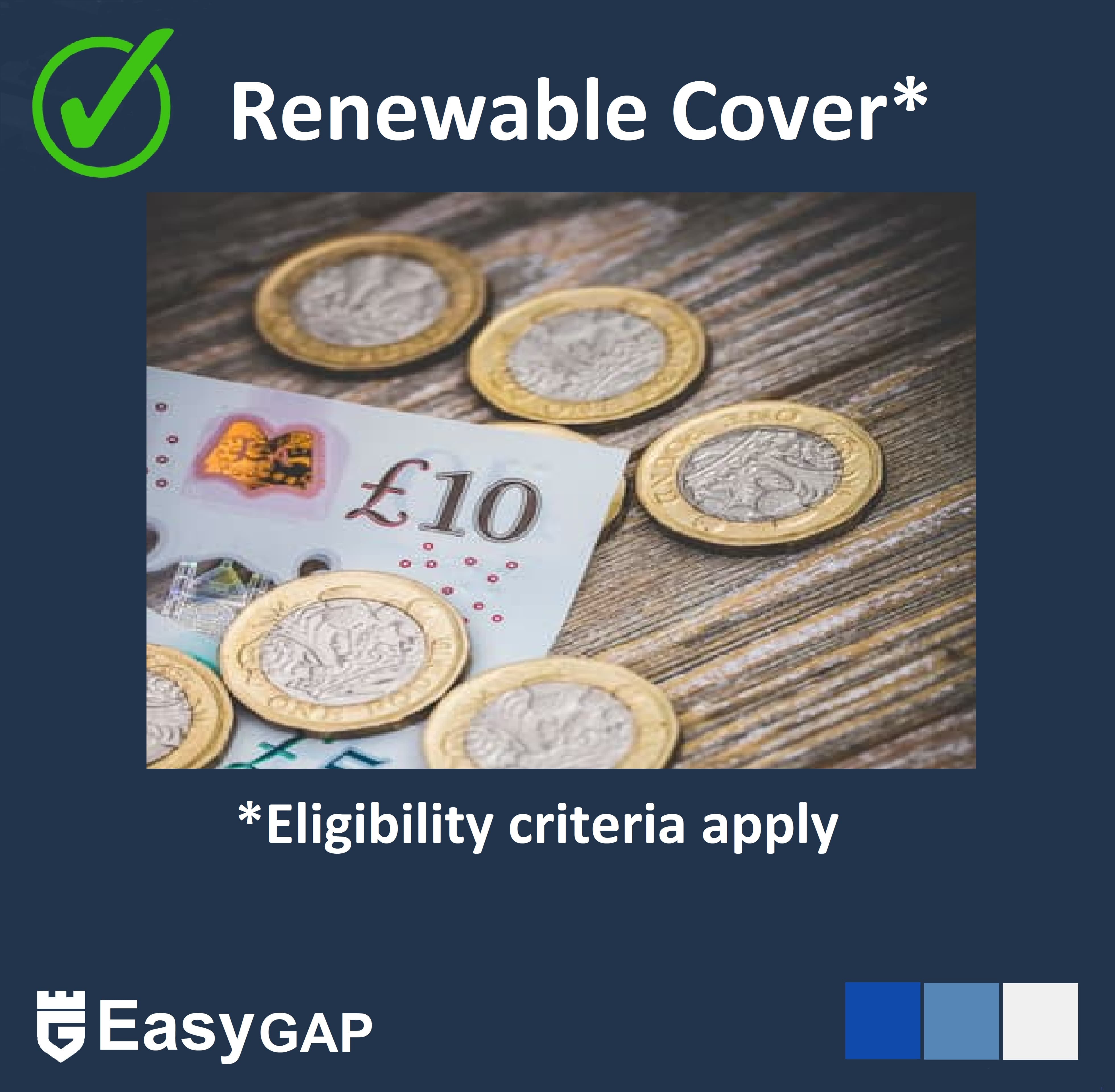Customer Service & Help Lines Open Mon-Fri 9am-6pm, Closed Saturday, Sunday
Calling from a mobile? Please call 0151 647 7556


Please note that the details on this page apply to policies purchased from Easy GAP as of June 17, 2025, with the policy identifier starting with EASYX. For policies purchased on, or before that date, with the start EGEX, please refer to the policy terms and conditions you were issued at the time of purchase.
Motor excess insurance is a policy that reimburses you for the excess amount you have to pay if you make a claim under your main car insurance. It covers the compulsory and voluntary excess charged by your motor insurer, up to a set limit. It's designed to reduce your out-of-pocket costs if you need to claim.
EasyGAP Motor Excess Insurance offers a solution for individuals seeking to protect their excess costs resulting from making a claim on their motor insurance policy. EasyGAP provides solutions that are often not found elsewhere. This includes Motor Excess Insurance for:
1. You buy EasyGAP Motor Excess Insurance for your vehicle. Your compulsory and voluntary excess from your motor insurance adds up to £650 so you buy excess insurance with a maximum claim limit of £750 to cover it.
2. Two months later, you bump your car. It was your fault, and the estimated cost of the repair is £1500.
3. Your car is repaired and you pay the £650 total excess charge.
4. You make your claim on your Motor Excess Insurance to claim back the £650 you have outlaid.
Motor Excess protection insurance can help. You can protect motor excess yearly from £250 to £1500, and prices start from £14.99 for a 12-month policy.
Why not click for an instant quote and cover and see how easy and affordable an excess insurance policy can be?
Avoid Paying Large Excess Bills
If you make a claim on your motor insurance, you’ll need to pay your excess, sometimes hundreds of pounds. This policy can provide refunds for that cost.
Protect Against Unexpected Costs
Accidents, theft, vandalism, and fire claims often happen without warning. Excess insurance softens the financial blow when they do.
Saves You Money on Your Main Insurance
Increasing your voluntary excess can lower your comprehensive insurance premium. Excess cover protects you if you ever need to claim.
Covers Multiple Claim Types
Whether it’s a minor bump or a larger claim, you can claim back the excess charged, as long as your main insurer pays out and you pay your excess (subject to terms, conditions and claim limits).
Ideal for High Excess or Low-Value Claims
Even a minor repair can result in an excessive charge. Excess cover can help ensure you’re not out of pocket.
Covers Named Drivers
EasyGAP policies can cover all named drivers on your valid motor insurance policy, not just the policyholder.
Peace of Mind for High-Risk Use Types
Great for couriers, taxis, young drivers and driving instructors, who may be more likely to make a claim and face excess charges regularly.
Your insurance company can ask you to pay for two types of excess on motor vehicles.
Increasing voluntary excess can significantly affect your insurance premium cost. Even a small increase in your voluntary excess can save hundreds of pounds, depending on driving history, age, claims history, etc.
See how we saved 27% on our annual motor insurance premium quotation by a simple adjustment to your voluntary excess on our sister site over at Total Loss GAP (Save on your insurance costs)
A higher excess amount, in theory, should reduce your annual insurance premium cost on your motor insurance. After all, you are committing to pay the first part of any claim with the excess. This lowers your motor insurance companies' risk, which can, in turn, mean a lower annual premium.
So, the temptation can be to have a high excess to reduce your annual insurance premium.
The downside is that higher excess charges mean you must pay more each time you claim your insurance policy. You may also see the smaller claims not paid, or contributed to, by your motor insurer.
The other important thing to consider is that if you take our motor excess cover to protect against these charges on an insurance claim, you have to pay your excess on the motor insurance claim to claim it back.
What do we mean by that?
Let's say you raise the voluntary excess to £750 and have a compulsory excess of £250, giving you an overall excess of £1000 on your motor insurance policy. If you have a claim following a minor accident, and the repair cost is only £800, your motor insurer will not pay out. This is because you have not exceeded the excess amount of your motor insurance.
In this instance, you would have to pay £800 for the repair cost with no contribution from your motor insurer. As you have not claimed on your motor insurance or paid any excess charges, you cannot claim on your motor excess insurance policy.
For policies purchased from 18th June 2025 with the policy reference starting EASYX. For policies starting ESYEX please refer to your policy documents.
Motor Excess Insurance is arranged by Niche Box Group Ltd (FRN: 967691) and Strategic Insurance Services Ltd (FRN: 307133)
GAPinsurance123.co.uk is a trading name of Aequitas Automotive Limited, which has it’s registered address at Aequitas House, 56 Hamilton Square, Birkenhead, Wirral, CH41 5AS (Companies House Company Number: 07347606. Aequitas Automotive Limited is authorised and regulated by the Financial Conduct Authority (FRN: 821163).
Motor Excess Insurance from GAPinsurance123.co.uk is underwritten by Collinson Insurance. Collinson Insurance (a trading name of Astrenska Insurance Limited) is authorised by the Prudential Regulation Authority and regulated by the Financial Conduct Authority and the Prudential Regulation Authority in the United Kingdom, under Firm Reference Number 202846. Registered in England number 01708613. These details can be checked on the Financial Services Register by visiting www.fca.org.uk
Claims are handled by the Davies Group. Please register your claim at https://excessprotectionclaims.davies-group.com
Easy Gap can offer private motor excess insurance cover on the following types of vehicles:
Vehicle uses can include:
No. We will issue a renewal quote (if available) approximately 30 days prior to your policy's expiration.
.
Please refer to our Excess Insurance policy documents for a comprehensive list of terms and conditions, as well as details on making a claim, lodging a complaint, and the cooling-off procedures.
Currently, we offer a range of maximum claim limits per annum. The claim limit is the most you can claim on the policy, either in a single claim or a cumulative of several claims during the policy term. Once you have exceeded this amoun,t the policy automatically expires. For example, with a £500 excess limi,t you can make one claim of £500, or two claims of £250. If you make two claims of £300 each, then the first one will be paid in full, but only £200 of the second claim will be paid. This is because you will have exceeded your maximum of £500 (£ 300 + £ 200).
Our range of maximum claim limits is currently:
Standard EasyGAP motor excess protection is available for cars, motorbikes and other vehicles for standard use. Riskier vehicle uses, like hire & reward, commercial use like taxi and courier or driving school, can all see slightly higher premiums quoted.
The premiums provided by EasyGAP for the motor excess insurance are, we believe, amongst the most competitive you will find in the UK today. We do look at our competitors' products and pricing, and we are confident that we provide good value in features and premium prices. Please check against other providers to see if our confidence is not unfounded.



Policies purchased after 18/06/2025
![]() EasyGap Vehicle Excess Insurance Terms
EasyGap Vehicle Excess Insurance Terms ![]() EasyGap Vehicle Excess Insurance IPID
EasyGap Vehicle Excess Insurance IPID
Policies purchased before 18/06/2025
![]() EasyGap Excess Insurance Terms
EasyGap Excess Insurance Terms ![]() EasyGap Excess Insurance IPID
EasyGap Excess Insurance IPID